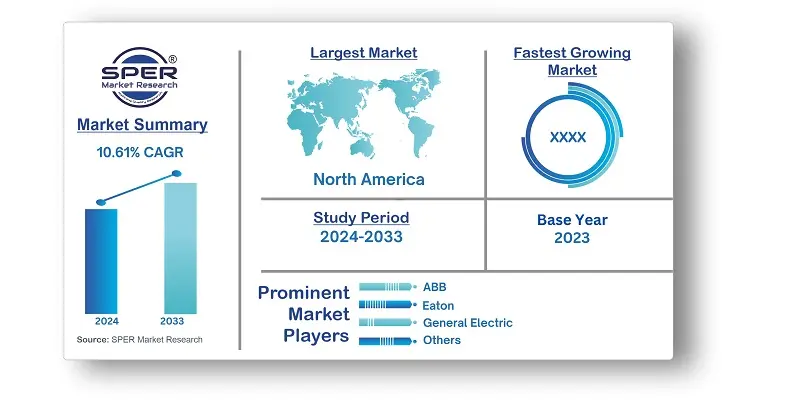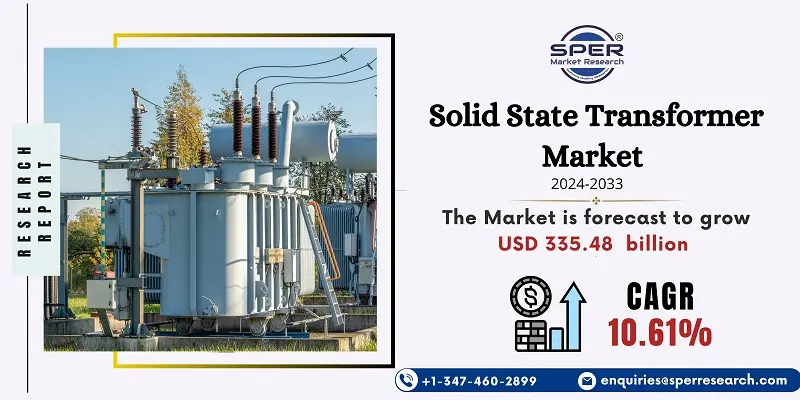
Solid State Transformer Market Growth, Size, Trends, Share, Demand, Revenue and Future Outlook
Solid State Transformer Market Size- By Type, By Voltage Level, By Application, By End User- Regional Outlook, Competitive Strategies and Segment Forecast to 2033
| Published: May-2024 | Report ID: SEMI2419 | Pages: 1 - 228 | Formats*: |
| Category : Semiconductor and Electronics | |||
- June 2022; Alstom, a pioneer in intelligent and sustainable mobility worldwide, and GTS Rail, a Bari based business that engages in multimodal rail freight transportation have reached an agreement for the supply of 20 Traxx DC3 electric locomotives, known as E.494 in Italy.
- October 2022; A 400kW extreme fast EV charger based on a next generation SiC MOSFET solid state transformer (SST) was demonstrated by Delta Electronics, Ltd., a subsidiary of Delta Electronics, Inc., to partners in its U.S. DOE grant program, including General Motors (GM), DTE Energy, Next Energy, Virginia Tech’s center of power electronics systems (CPES), and the American Center for mobility.


| Report Metric | Details |
| Market size available for years | 2020-2033 |
| Base year considered | 2023 |
| Forecast period | 2024-2033 |
| Segments covered | By Type, By Voltage Level, By Application, By End-User |
| Regions covered | North America, Asia-Pacific, Latin America, Middle East & Africa and Europe |
| Companies Covered | ABB, Eaton, General Electric, GRIDBRIDGE, MASCHINENFABRIK REINHAUSEN GMBH, Mitsubishi Electric Corporation, Schneider Electric, Siemens, and Varentec, Inc., Others. |
- Utilities and Energy Providers
- Industrial and Commercial Enterprises
- Electric Vehicle (EV) Charging Infrastructure Developers
- Data Centers
- Renewable Energy Sector
- Smart Grid Technology Developers
- Research and Development Organizations
| By Type: |
|
| By Voltage Level: |
|
| By Application: |
|
| By End-Users: |
|
- Global Solid State Transformer Market Size (FY’2024-FY’2033)
- Overview of Global Solid State Transformer Market
- Segmentation of Global Solid State Transformer Market by Type (Distribution Solid State Transformer, Power Solid State Transformer, Traction Solid State Transformer)
- Segmentation of Global Solid State Transformer Market by Voltage Level (HV/MV, MV/LV)
- Segmentation of Global Solid State Transformer Market by Application (Alternative Power Generation, Electric Vehicle Charging Stations, Power Distribution, Traction Locomotives)
- Segmentation of Global Solid State Transformer Market by End-User (Energy Transportation, Others)
- Statistical Snap of Global Solid State Transformer Market
- Expansion Analysis of Global Solid State Transformer Market
- Problems and Obstacles in Global Solid State Transformer Market
- Competitive Landscape in the Global Solid State Transformer Market
- Impact of COVID-19 and Demonetization on Global Solid State Transformer Market
- Details on Current Investment in Global Solid State Transformer Market
- Competitive Analysis of Global Solid State Transformer Market
- Prominent Players in the Global Solid State Transformer Market
- SWOT Analysis of Global Solid State Transformer Market
- Global Solid State Transformer Market Future Outlook and Projections (FY’2024-FY’2033)
- Recommendations from Analyst
1.1. Scope of the report1.2. Market segment analysis
2.1. Research data source2.1.1. Secondary Data2.1.2. Primary Data2.1.3. SPER’s internal database2.1.4. Premium insight from KOL’s2.2. Market size estimation2.2.1. Top-down and Bottom-up approach2.3. Data triangulation
4.1. Driver, Restraint, Opportunity and Challenges analysis4.1.1. Drivers4.1.2. Restraints4.1.3. Opportunities4.1.4. Challenges4.2. COVID-19 Impacts of the Global Solid State Transformer Market.
5.1. SWOT Analysis5.1.1. Strengths5.1.2. Weaknesses5.1.3. Opportunities5.1.4. Threats5.2. PESTEL Analysis5.2.1. Political Landscape5.2.2. Economic Landscape5.2.3. Social Landscape5.2.4. Technological Landscape5.2.5. Environmental Landscape5.2.6. Legal Landscape5.3. PORTER’s Five Forces5.3.1. Bargaining power of suppliers5.3.2. Bargaining power of buyers5.3.3. Threat of Substitute5.3.4. Threat of new entrant5.3.5. Competitive rivalry5.4. Heat Map Analysis
6.1. Global Solid State Transformer Market Manufacturing Base Distribution, Sales Area, Product Type6.2. Mergers & Acquisitions, Partnerships, Product Launch, and Collaboration in Global Solid State Transformer Market
7.1. Global Solid State Transformer Market Size, Share and Forecast, By Type, 2020-20267.2. Global Solid State Transformer Market Size, Share and Forecast, By Type, 2027-20337.3. Distribution Solid State Transformer7.4. Power Solid State Transformer7.5. Traction Solid State Transformer
8.1. Global Solid State Transformer Market Size, Share and Forecast, By Voltage Level, 2020-20268.2. Global Solid State Transformer Market Size, Share and Forecast, By Voltage Level, 2027-20338.3. HV/MV8.4. MV/LV
9.1. Global Solid State Transformer Market Size, Share and Forecast, By Application, 2020-20269.2. Global Solid State Transformer Market Size, Share and Forecast, By Application, 2027-20339.3. Alternative Power Generation9.4. Electric Vehicle Charging Stations9.5. Power Distribution9.6. Traction Locomotives
10.1. Global Solid State Transformer Market Size, Share and Forecast, By End-Users, 2020-202610.2. Global Solid State Transformer Market Size, Share and Forecast, By End-Users, 2027-203310.3. Energy Transportation10.4. Others
11.1. Global Solid State Transformer Market Size and Market Share
12.1. Global Solid State Transformer Market Size and Market Share By Region (2020-2026)12.2. Global Solid State Transformer Market Size and Market Share By Region (2027-2033)12.3. Asia-Pacific12.3.1. Australia12.3.2. China12.3.3. India12.3.4. Japan12.3.5. South Korea12.3.6. Rest of Asia-Pacific12.4. Europe12.4.1. France12.4.2. Germany12.4.3. Italy12.4.4. Spain12.4.5. United Kingdom12.4.6. Rest of Europe12.5. Middle East and Africa12.5.1. Kingdom of Saudi Arabia12.5.2. United Arab Emirates12.5.3. Qatar12.5.4. South Africa12.5.5. Egypt12.5.6. Morocco12.5.7. Nigeria12.5.8. Rest of Middle-East and Africa12.6. North America12.6.1. Canada12.6.2. Mexico12.6.3. United States12.7. Latin America12.7.1. Argentina12.7.2. Brazil12.7.3. Rest of Latin America
13.1. ABB13.1.1. Company details13.1.2. Financial outlook13.1.3. Product summary13.1.4. Recent developments13.2. EATON13.2.1. Company details13.2.2. Financial outlook13.2.3. Product summary13.2.4. Recent developments13.3. GENERAL ELECTRIC13.3.1. Company details13.3.2. Financial outlook13.3.3. Product summary13.3.4. Recent developments13.4. GRIDBRIDGE13.4.1. Company details13.4.2. Financial outlook13.4.3. Product summary13.4.4. Recent developments13.5. MASCHINENFABRIK REINHAUSEN GMBH13.5.1. Company details13.5.2. Financial outlook13.5.3. Product summary13.5.4. Recent developments13.6. MITSUBISHI ELECTRIC CORPORATION13.6.1. Company details13.6.2. Financial outlook13.6.3. Product summary13.6.4. Recent developments13.7. SCHNEIDER ELECTRIC13.7.1. Company details13.7.2. Financial outlook13.7.3. Product summary13.7.4. Recent developments13.8. SIEMENS13.8.1. Company details13.8.2. Financial outlook13.8.3. Product summary13.8.4. Recent developments13.9. VARENTIC INC13.9.1. Company details13.9.2. Financial outlook13.9.3. Product summary13.9.4. Recent developments13.10. Others
SPER Market Research’s methodology uses great emphasis on primary research to ensure that the market intelligence insights are up to date, reliable and accurate. Primary interviews are done with players involved in each phase of a supply chain to analyze the market forecasting. The secondary research method is used to help you fully understand how the future markets and the spending patterns look likes.
The report is based on in-depth qualitative and quantitative analysis of the Product Market. The quantitative analysis involves the application of various projection and sampling techniques. The qualitative analysis involves primary interviews, surveys, and vendor briefings. The data gathered as a result of these processes are validated through experts opinion. Our research methodology entails an ideal mixture of primary and secondary initiatives.



Frequently Asked Questions About This Report
PLACE AN ORDER
Year End Discount
Sample Report
Pre-Purchase Inquiry
NEED CUSTOMIZATION?
Request CustomizationCALL OR EMAIL US
100% Secure Payment






Related Reports
Our Global Clients
Our data-driven insights have influenced the strategy of 200+ reputed companies across the globe.




















